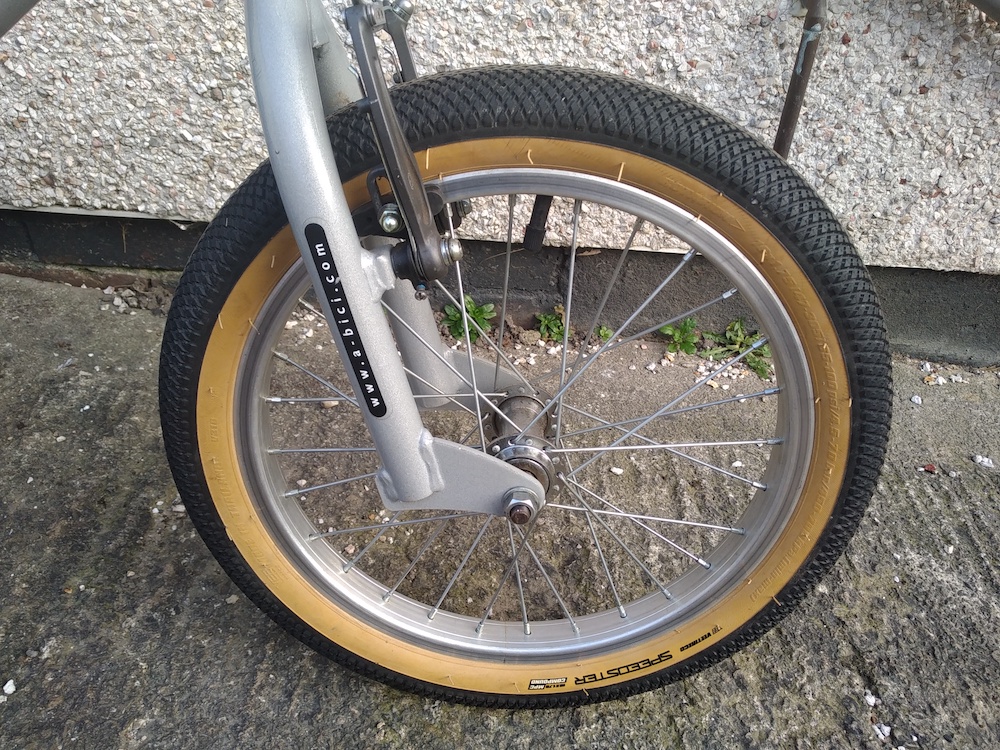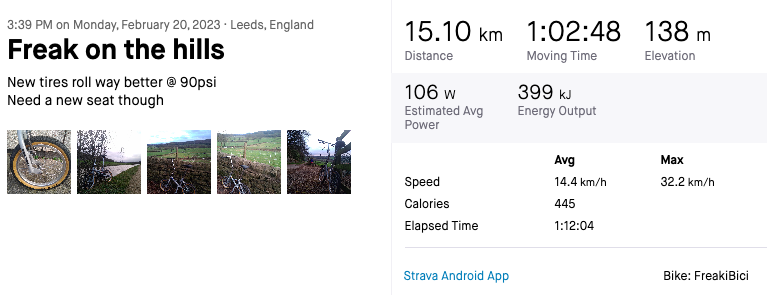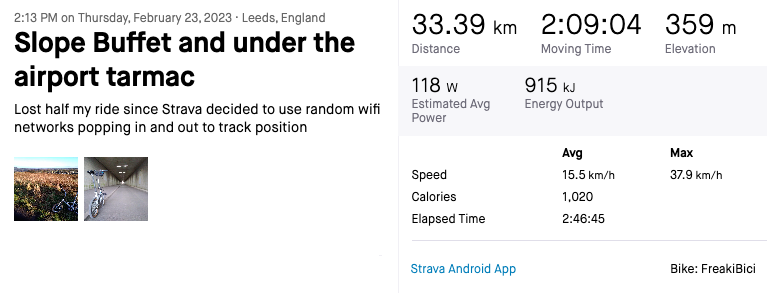
The A-Bici is a folding bike manufactured in Italy in the early 2000s which featured a folding handlebar stem, folding pedals, and a sliding seat post to pack into a smaller space for multi-modal cycling. Its intended target market seemed to be vacationers. Most of the components (folding stem, handlebars, seatpost and frame) were made from steel.

Here are its other stock specs:
- 16" x 1.75" (ETRTO 305mm) low pressure tires running at 35 psi max
- Single speed with a very low effective gear ratio
- Upright seating position
- Swan necked handlebar stem (to avoid knees striking the handlebars during pedal stroke)
- Front and rear cantilever brakes
- Aluminum wheels
- Official weight was 11.8 kg
- Official packed volume was 1010 x 290 x 630 (cm)
- Came with a logo-brazen handlebar bag which could hold a toolkit
- Folding pedals, singled sided
See more at the archived copy of the original product website (courtesy of the Wayback Machine): a-bici.com
I found a pristine example of this bike locally for a mere £15, making it possibly the best value cycling deal I’ve gotten so far.
+Modification: New high-pressure tires
First modification that had to be done was to get better rolling tires for the bike. 35psi was too low pressure for a faster ride. After a bit of search (vee speedster 16) on eBay, I came upon some Vee Speedster tires in the 305mm size. These ran at 85 - 110 psi. After winning the auction and forking over £15, they arrived and were installed onto the wheels. The riding experience was much smoother, both in terms of the very low rolling resistance and the amount of grip on the road.

+Modification: New saddle
Everybody has their own preferred saddle shape and firmness. Changing the saddle is one of the easiest and most effective ways to improve the ride of any bike. The original saddle was far too soft for me so I bought a new Selle Italia XC-1 saddle for £10. It had both the correct shape and stiffness to prevent discomfort over longer rides.
+Modification: V-Brakes
The original cantilever brakes weren’t very effective at stopping the bike and the brake arms kept catching my pant legs while riding the bike. So some V-brakes were scrounged from the bike parts bin and replaced the poorly performing canti brakes. Stopping power was increased and I felt more confident riding the bike after this upgrade.
Shakedown rides
Once the new brakes were installed and weather permitted, I decided to take the bike out for a few shakedown rides (18km and 30km) to see how the bike would fare when thrown some distance and hills. It performed very well, though the riding characteristics take some getting used to:
- Upright seating stance
- Low gearing meant the bike constantly was spinning out on flat sections of the route
Rider’s weight was mostly over the rear wheel, making the front of the bike very light. When combined with the high-torque of the low gear ratio and upright seating style, the front wheel lifted off the ground on more than a few occasions! A rider really needs to consciously shift their weight toward the front to prevent such front wheel liftoff.
+Modification: New front rack
Mounting a rack would help lower its center of gravity and also dampen the ride a bit since riding weight was concentrated towards the rear. A used headset mounted front rack showed up on the local FB marketplace which only cost £25 shipped. Although it no longer wants to wheelie half the time, with the rack fully loaded you feel every little bump.
Greatly increased storage capacity and improved handling resulted from this simple mod.
+Modification: aluminum 15 degree swept-back handlebars
Swept-back handlebars are better suited for relaxed riding positions as they allow the wrists to be held at a more natural position. I found a nice one on Aliexpress for £6. Additional riding comfort and slightly lightened weight compared to the steel stock handlebars were the benefits of this upgrade. It also looks better!
+Modification: aluminum seat post
Another basic substitution was the swapping of the steel seatpost for an aluminum example with an integrated saddle rail mount. The aluminum post is not only lighter but the design of the rail mount prevents the saddle angle from unexpectedly changing during a ride when heavy bumps are encountered. Moreover, it’s much easier to adjust. Shipped from factory, it cost only £19 from AliExpress. The bike gained some ease of adjustment and minor weight savings.
+Modification: 3-speed Sturmey-Archer rear wheel
The low gearing was nice for hillclimbs but limited the speed on flats. Since it was clear that the bike wasn’t getting any lighter, I set out to find a 3-speed rear wheel to install on the bike. I had to cannibalize this wheel from a donor bike in poor condition which was bought for £30. Replacing the grip-shift with a trigger style shifter (to avoid accidental shifts just holding onto the handlebars) set me back an additional £7. Once installed and properly adjusted I could not only climb hills as before, but also maintain a decent speed on flat ground as well; this greatly increases the versatility of the bike.
Replacement: folding stem and handlebars
After riding a particularly treacherous section of the local canal towpath, I managed to break the stock folding stem by material stress from all the jolting on the bars. The bike was out of commission for a period of 2 weeks until I was able to remove the broken stem and source an inexpensive combination of non-folding stem quill stem + BMX bars to recreate the amount of height and offset away from the headset. Total cost of this was £40, most of that due to the unusually long quill stem which I had to buy new.
Photos of the broken stem replacement:
Longest ride as of May 2023
I rode out to meet the Chorlton Wanderers for a York-to-Hull ride on 2023-04-30. The longest distance ridden in a day on the bike so far:
A great ride marred initially by some incredible headwinds but mitigated by finding a good way to change to a more “aero” stance instead of riding fully upright.


